The Michel Vaillant adventure 'Suspense à Indianapolis'
Where fantasy and reality met - and about that reality
Author
- Henri Greuter
Date
- March 23, 2023
Related articles
- Michel Vaillant - Le Grand Défi by Jean Graton, first of the Michel Vaillant comics: Some reflections and even more reflections, by Henri Greuter
- 1964 Indianapolis 500 - The Indy 1964 second-lap disaster, Closing in on the truth, by Henri Greuter
- Ferrari at Indianapolis - Mutual love unanswered, by Henri Greuter
Who?Michel Vaillant What?Vaillante Spéciale Indianapolis Where?Indianapolis When?1964/1965 Indianapolis 500 |
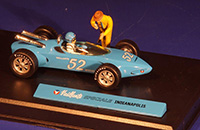 |
Why?
I must start my reflections with a disclaimer. No comment and no observation in this piece is meant to downgrade the work of Jean Graton. Nothing what reads as or appears to be negative must be regard as being negative. I have no reason to be negative about Jean Graton and his work because I am one of the many readers of his albums who owe a lot of their interest for motor racing to the albums he created. And I have more reasons to credit Suspense à Indianapolis as one of the main sources of inspiration for all that.
If there was a Hall of Fame for those who have promoted motor racing I will nominate Jean Graton instantly.
Secondly, it is possible that elsewhere articles like these have been published about the Vaillant albums, if not in Englishm then perhaps in other languages. I hereby want to state, maybe must confess, that I have not done a detailed search for such articles so if there are any, I simply was not aware of their existence at the time of writing (first half of 2020). The first version of this article was published on the Autosport Nostalgia Forum on May 23, 2020. The version presented here is a corrected, updated and extended version of that original. Some comments posted as a reply on the piece have been included and used for this updated version.
Then... This write-up would probably benefit from the inclusion of drawings taken from the album discussed here. Due to wanting to honour and respect the copyrights of the author and current copyright holders I can't bring myself to doing so. The same goes for pictures of which I can not locate the copyrights and/or obtain permission to reproduce then.
Finally, an expression that is very familiar today, 'Indycar'. did not yet exist in the sixties. On occasion I use the expression in this write-up for reasons of convenience but I do acknowledge that it is not an expression used for the cars that I mention and discuss.
Suspense à Indianapolis is the eleventh album of the Michel Vaillant series, released in September 1966. It is to some extent the follow-up of the tenth album, L'Honneur du Samourai, which appeared less than half a year earlier. Before it was released as a complete album adventure it appeared in the (Belgian) Tin-Tin weekly magazine between November 3, 1964 and April 13, 1965 (n° 44/64 to 15/65).
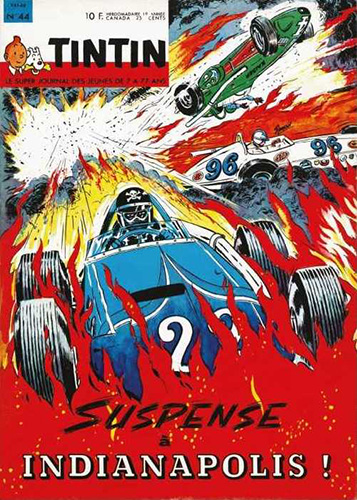
The first part of Suspense was printed in the 44th edition of the weekly magazine TinTin in the year 1964. The cover of that edition looked like this and it was to some extent some kind of indication of what was going to happen within that adventure. Quite a chilling scenery when we remember the events that did take place a mere six months earlier.
In L'Honneur du Samourai the story deals with an F1 season that appears to have been either 1964 or 1965 which was lost by Michel but instead his team mate and friend, Steve Warson, took the world title for the Vaillante team.
For a description of the story presented in Suspense à Indianapolis I have used the Dutch translation of the story. To my knowledge, this adventure has not been released in an English translation. A pity, as there might have been a market for it in the US.

A fairly recent front cover of the French version of Suspense à Indianapolis, other versions used what was basically the same drawing, albeit possibly with some slight variations in colour.
SPOILER ALERT: the plot of the adventure
In the early part of Suspense à Indianapolis it is Steve who shortly after winning the F1 world title suggests to the Vaillant family that in order to make up for the disappointment of Michel losing the crown he should try to win the 'Championship of the United States'. Steve has had some talks with the organisers already and they have reacted positively. But in order to participate, Vaillante has to build two entirely new cars, a sports car for events at Daytona and Riverside and a single-seater for the Indianapolis 500.
Vaillante's plans to compete in the US championship don't go down well at all with a privateer racing team located in Texas named the Texas Drivers Club, a team that are sworn enemies of initially only Steve Warson. After the first encounter between Steve and his enemies on European soil (in album no.5: No 13 au depart) the Texas Drivers become the sworn enemies of the Vaillante team and thus Michel as well.
After hearing about the talks between Steve and the organizers of the Championship of the United States, the Texas Drivers Club fear for their chances and the future of their club and in order to prevent Vaillante from competing at Indianapolis they infiltrate in the Vaillante factory, carrying out a bomb attack on the Competition department of Vaillante to undo all the work done on the Indycar. Some action to minimise the damage is done thanks to a mysterious telephone call the Vaillants receive shortly before the bomb goes off. A quick reaction by the people still at the factory makes sure that the damage is less extensive as otherwise would have been the case.
Michel and Steve get their new sportscars in time to participate at Daytona in a 1000km event organized by NASCAR which is won by Michel. The second event is at Riverside, also for sportscars and this time Steve wins the race, which turned into a wild rodeo ride with more than half the field wiped out.
In those two sportscars events, the Texas Drivers Club enter three entirely different cars for their three current drivers still eligible to race. The first car is an early version of the Ford GT40 driven by a driver named Jones (his Christian name is never mentioned in the entire album), a rear-engined open-cockpit Scarab for Sam Hawkins and a Cheetah-Chevrolet for a driver named Payntor. His Christian name is also never mentioned but in a later story he appears again and then we are told that his Christian name is Donald.
Jones in the GT40 turns out to be the most formidable opponent of the three Texas entries in both events, finishing third and second.
At Indianapolis, Jones is driving a Lotus-Ford (numbered 2), Payntor and Hawkins are driving front-engined cars (so-called 'Roadsters') numbered 4 and 5 respectively. Team Vaillante brings two very elegant looking rear-engined cars to Indianapolis. Michel and Steve take the first two starting spots but soon they find out that they are in danger. A friend of Steve's who works for the FBI appears at Indy and tells them he has received a message that Steve and Michel need his protection. Steve and Michel make it known that they will spend some time 'in the mountains' and leave the following day. Once the president of the Texas Drivers Club hears about these plans he organises an assault on Michel and Steve's car to be pushed off the road by a truck. Michel and Steve are hospitalised and out of the race.
On Race Day, shortly before the start of the race, the president of the Texas Drivers Club is informed that one of his drivers he had trusted, Payntor, is responsible for the telephone call that enabled Vaillante to minimise the damage to the Indycar during the bomb attack in the factory. Literally seconds after hearing this news, he spots, as if out of nowhere, Steve and Michel in good shape, ready to race. The spokesman of Team Vaillante explains that they knew about a likely attack on their drivers and a decoy plan was worked out to keep Michel and Steve safe and out of sight with two FBI men taking their place. These two men were indeed hospitalised yet much less severely injured as was told until then.
The Texas 'capo' immediately calls for a driver to replace Payntor. When this mysterious driver shows up, he appears so menacing that both Steve and Michel have a suspicion with whom they now have to deal.
The race starts with a massive fiery accident, even more gruesome than the 1964 disaster already was (no details on the outcome for the drivers involved).
Now, in the Dutch translation of the album the situation becomes rather confusing at this stage. First there is a discussion between team boss Henri Vaillant (Michel's dad) and his eldest son Jean-Pierre that the cars are expected to make a stop for fuel soon. Some cars are seen being refuelled and then it is mentioned that the Vaillantes wil start their charge to the lead about halfway into the race. In order to that they must pass the two Texas Drivers Roadsters that run as a pair. However, it is unclear whether this is by now the halfway point of the race already, but as several cars have already stopped for fuel it can't be that early in the race anymore.
Anyway, when Michel and Steve want to overtake the #4 Texas Drivers Roadster driven by Payntor's mysterious replacement, he refuses to make way. Then he becomes under attack of his team mate Sam Hawkins in the other (#5) Texas Drivers Roadster who makes contact with the #4! Both cars almost spin out but remain on track. Both Michel and Steve use the opportunity to pass the battling team mates and move forward through the field.
By then the story goes to what is said to be the halfway point of the race, with the two Texas Roadsters by now a lap behind but still driving on as a pair. Together with some other cars Steve and Michel are ready to lap the two Texas cars which are still running together. Since one of the leaders is the Texas Drivers Lotus-Ford of Jones, the mysterious driver in Roadster #4 prepares to help his teammate. But yet again it is Sam Hawkins who runs his own car into the #4 to prevent any actions by the driver in #4. This time, however, the cars spin off the track. The two Texas Drivers get out of their cars and start a fistfight!
When officials and police rush in it turns out it wasn't Sam Hawkins who drove his own (#5) car but Payntor who had taken Hawkins' place. Payntor then identifies the driver of his own car (the #4) as Steve Warson's arch enemy Bob Cramer. Payntor explains to the police and other bystanders that he knew that he was going to be replaced by Cramer, the most evil of all Texas Drivers, and that Cramer was sent out to disturb Michel and Steve's race.
Payntor explains to the police how he always dreamt about becoming a great racing driver but realised that he had become a gangster instead, and how by now he was fed up with everything he was forced to do and got involved in. So he secretly warned the Vaillants in Paris and later on the FBI.
When all Texas Drivers Club members are arrested and taken from the track, the speaker reveals that the Vaillantes of Steve and Michel have not made their pit stops for fresh tyres yet. The explanation is given that they are using special new tyres brought from Europe that are good enough to last the entire race and will save them the time otherwise lost in tyre changes. This helps Michel to win the race and become the 'Champion of the United States'.
Wow, what a story.
But how often have you had thoughts that started with 'But how?', 'But when?' or a variation of that?
Reflections and observations
A few details in this plot are entirely impossible, and unrealistic to begin with, but it is a graphic story dealing with a racing world of which most of the audience this book aimed at knew little to nothing. So you can get away with a lot and there is no-one that will stop you. But let's ask some questions and try to find the answers and see how close the album reflected the actual situation or, when it didn't, how it was different from the truth.
?1: When could this adventure have taken place?
OK, so let's take a good look at this adventure and see what was real or could have been real and what was sheer fantasy. First question is, of course, when did this adventure take place?
I will get back to this later but there is one type of publication that tells us that Suspense is a 1964 event. This publication is not a Michel Vaillant story or any other official Graton Editeur publication. Another argument going for 1964 is that, just like the real 1964 race, Graton's race saw a horrible fiery crash involving several cars early on in the race. Then there is the fact that the story has been compiled in 1964, appearing in print in a weekly magazine from late 1964 on.
But I would rather focus on the actual Michel Vaillant albums themselves as well as the actual situation of the racing world as it was in that period of time to answer this question.
The strongest arguments I can make are for the year being 1965. To come to this conclusion, however, you need to make a side step to the previous album. In L'Honneur du Samourai a Japanese driver appears who has bought a Lotus chassis and fitted it with a Honda engine. Honda made its debut in F1 (using V12 engines) in 1964. Curious detail: if we assume that L'Honneur du Samourai is a 1964 adventure, this Japanese driver debuts his Lotus-Honda even earlier in the race season than the actual factory Honda team in the real 1964 GP season. Now for the purists: I must mention that the 1964 Honda factory V12 car had its engine mounted transversally in the chassis while Graton's Lotus-Honda appears to have the engine mounted conventionally (longitudinally). So has the real Honda engine even been an inspiration for Graton?
Anyway, remember that the adventure in this album and the outcome of it inspired Steve's plan, so that logically makes the next year (when Suspense à Indianapolis took place) 1965.
The first plans and the talks about it in the Vaillante Organisation take place after this (1964) season but there is no talk about commitments to continue in F1, not one single reference. But in these talks, chief designer (Michel's older brother) Jean-Pierre Vaillant recalls having seen how Jim Clark almost won the Indy 500 the year before. Such did indeed happen in 1963, thus suggesting that the talks have taken place after the last F1 race of 1964. In real life, that was the Mexican GP held on October 25 of that year. Later on in the script, in a conversation between Jean-Pierre and Michel, Jean-Pierre gives a round-up of cars that appeared at Indy of which he had obtained information in order to start a study on what would be needed for Vaillante to build a decent car. The round-up by Jean-Pierre consists of a list of cars that were entered for the 1964 event and some of them actually qualified for the race.
By the way, I can truly imagine that when the album was released in 1966 the majority of the readers (mostly living on the European continent) were very likely unfamiliar with Indy in the mid-sixties. All those names that supposedly were cars must have been regarded as bewildering. If you were familiar with names of manufacturers like Ferrari and Lotus or constructors like Cooper and Brabham, the list given by Jean-Pierre may have caused some wonder about what this was all about.
Anyway, the task for Vaillante is a massive one. As mentioned, the first talks about entering the 'Championship of the United States' can at best have taken place late October 1964. In that era, the actual race at Indianapolis traditionally took place on May 30th, Memorial Day in the US, but practice and qualifying starting much earlier. So in order to participate, Vaillante had the monumental job of designing and building an Indycar in little over six months. If we keep in mind that it took Lotus and Ford a lot of efforts to get their combined 1963 efforts off the ground in less than a year, the challenge becomes obvious.
But that's not even all the work! For the two other races preceding Indy (no indication of when those actually took place) they also had to design and build a new sportcar prototype! In fact, Vaillante actually built four examples of this prototype and they were finished even before the Indycar was. Not a single detail or spec is given about this particular sportscar, like for example what kind of engine it had. Now, how much work for these projects had been done at the Vaillante factory already, in particular for the sportscar, no clue is given. But for those cars there was even less time available to design and build them, since they were needed for events held before Indianapolis!
Then again, as we already know from earlier adventures, the Vaillante designers and engineers are capable of miracles. In the sixth adventure of the series (La trahison de Steve Warson) the Vaillante team is in desperate need for a car suitable to run in the Panamerican road race in Mexico, revived for the occasion, and within less than two months the company designs and builds two brand new cars (Vaillante Panamericana, in later albums branded the Le Mans GT) that went on to actually win the event. So what's new for the factory in order to provide Michel and his friend Steve with a brand new, sorted out sportscar within the time frame of a few weeks?
About this particular sportscar built for the 'Championship of the United States', in modern reprints of the older albums I found overviews of different Vaillantes as they appeared over time. The sportscar debuting in Suspense is one of them and it is designated the Vaillante 'Daytona' Proto-GT. The name is likely derived from the track where the car made its race debut. I found websites dealing with Michel Vaillant that mention the car to be a 1964 model, thus suggesting the Suspense album to be a 1964 adventure. Curiously enough, one of these websites also listed the Indianapolis car that was eventually built to be a 1965 model. Would we then have more than a year between the first race (Daytona) and the third one (Indianapolis) within the space of one album?
But some more comments on the year of this adventure later on. In the next section I will introduce more data and facts that can be used in discussions about the time frame of the adventure. We will get back to this.
?2 The 'Championship of the United States': what's there to tell about that?
Next up is this 'Championship of the United States'. This is by far the biggest fantasy that author Jean Graton allows himself within this particular album. A championship like Graton described, consisting of two sportscars races and the Indy 500, simply did not exist and it is very unlikely anything like it could ever exist.
In the album, the race at Daytona was organized by NASCAR but it was an event for sportscars, so not for the stock cars for which NASCAR is better known, since that organization focused primarily on racing street-legal production cars. However, sportscar races were held at Daytona since 1962 using parts of the oval as well as the infield track, so this event could have been the one that Graton envisioned as used within his championship. By the way, Graton's event wasn't a 24-hour race as the Daytona sportscar race started out as a 3-hour event in 1962, became a 2000km race from 1964 on and only became a 24-hour race in 1966. So we have no reason to wonder how a Daytona sportscar race that wasn't a 24 hours race yet is included in Suspense.
There is no mention of the organiser of the second event at Riverside, and no clue given either for us to figure out which organisation it could have been. But the facility was known to be used for a variety of races by different formulae, as different sanctioning bodies were active over there, with NASCAR just one of them.
In that era, Indianapolis was organised and sanctioned by USAC (the United States Auto Club), which mainly concentrated on open-wheelers. Indy was part of USAC's 'National Championship', a series held for open-wheeled cars. In the early sixties, the majority of the events had been on dirt-track ovals but another event that was part of the championship was none other than the Pikes Peak hillclimb. In the album, however, not the slightest referral is made to any of these other events on the USAC calendar. In the mid-sixties the championship's focus slowly shifted towards paved ovals but one thing about that USAC championship remained the same: Indianapolis was by far and away its most important event.
So, both NASCAR and USAC organised their own championship, and they were not exactly in excellent standings with another. let alone both ever combining forces for a single championship. So much for the 'Championship of the United States'.
Sportscars and GTs were kind of popular in certain areas in the US but stock car racing and the USAC single-seater categories were generally better known. So in order to get a series that combined these three tracks in the story, Jean Graton simply created his own championship, there was no-one to stop him, and why should he be stopped?
And so Suspense à Indianapolis shares something with Graton's very first album: Jean Graton created an imaginary championship to be contested by his hero in which Indianapolis is one of the events, and then he conceived a plot to make it work.
?3: About the cars that appear in the story, the real ones and the imaginary ones
The Daytona and Riverside races provide Graton with the opportunity to draw a lot of cars common for the time, both GTs and sportcars: Ferraris, Maseratis, Cobra Daytonas, a wide variety. The main opponents, the Texas Drivers Club have an early version of the Ford GT40 which is of course a fairly familiar car for many race fans, both nowadays and back then. The two other 'Texas' cars are much less familiar and exotic but they were inspired on existing cars. The second car is a Cheetah-Chevy which must have made some impression as well on young readers unfamiliar with the American hardware. The third 'Texas' car is another rarity, an open-cockpit, mid-engined Scarab. Although Scarab is an existing brand, they are best known for their front-engined sportscars and a 1960 F1 project with a front-engined car, but the last-ever Scarab built was indeed a rear-engined open sportcar and obviously, Graton had seen this car or pictures of it since the Texas Drivers' car resembles the real one quite well.
By the way, by making this Scarab a part of the story Graton continued another tradition. In his third album (Le circuit de la Peur, released in July 1961) Graton brought in one of the earlier Scarab sportscars and the front-engined F1 car as well. Scarabs were certainly no strangers in the early Michel Vaillant albums.
Where Graton exactly found his inspiration for the cars is unclear, but there were all kinds of magazines available in those days so it can't have been too much of a challenge for him.
But Indianapolis is the main event in the Suspense album. Very early on in the album, there is a meeting of board members of the Texas Drivers Club where the club president brings the importance of Indy to everyone's attention. In the past they had fielded some decent drivers but the cars had let them down, although things looked much better for the upcoming event for which the team had acquired two, what were said to be extraordinary cars. But success would no longer be certain, should the Vaillantes appear at Indy.
I must say that the Texas Drivers must have had a tremendous amount of respect for a company with no recent experience of building cars for Indianapolis and racing them there since the late fifties!
The two extraordinary cars for Indy that the Texas Drivers will enter are mentioned by name: they are Novis. Graton thus once again brings back this remarkable brand in one of his albums. In his very first album Le Grand Defi which also has an Indy race he handed a starring role to a Novi, and in his second album Le Pilote sans Visage he creates an imaginary American-built F1 car, loosely inspired on the genuine Novi Indycar and names it the Novi Europ. All together, there are several reasons for Graton to pick up where he has left and continue his interest in the Novi.
I obtained my copy of Suspense late 1973. At that time, Indianapolis got little to no attention in the local press in my country. Then, some two years later, I found out that there have been real Novi race cars. On that occasion I did not see pictures of a car that resembled the Texas Drivers Novis, but the actual first Novi that I saw in a picture did resemble the white #1 in Le Grand Defi. It took me another nine years to find out more about the actual Novis that were built, so I can give the following details as they were at the time when the adventure was created by Graton.
In real life, Novis still raced at Indy in 1965 but the end of the line for these legendary cars and their equally legendary engine was in sight. In 1965, the cars and engines were owned and maintained by the Granatelli brothers (high-profile Andy and his brothers in the background, Joe and Vince) who bought the inventory from first owner Lew Welch early 1961. Under their guidance the 2.8-litre supercharged V8 was modernised and rejuvenated and its power output increased from some 600hp to a bewildering 775hp in 1965. The brothers initially used one of the two existing 1956-built Kurtis Kraft 500F chassis in the first year they owned the team, but in 1962 they replaced the aging 500F chassis (that inspired Jean Graton for Steve's white Novi #1 in Le Grand Défi) with two new cars built by Kurtis-Kraft dubbed the type 500K. In 1964, the Granatelli brothers order a 4WD car built by the British Ferguson company and then, in 1965, they built their own chassis fitted with a Ferguson 4WD drivetrain.
Given how the team was organised, it was absolutely impossible that any of the existing Novi cars and engines could be hired by another team, let alone being sold and ending up in different hands. For those who care to know: between 1961 and 1965 the Granatellis owned a total of six different Novi V8-powered chassis. The two oldest chassis were retired after the 1963 race and never in the years between 1961 and 1965 the team had more than four different chassis available. But out of these four cars, the Granatellis never used more than three cars at the same time, the fourth car not in existence yet or one of the two older cars still used being parked. Cars or engines were never made available to anyone outside the Granatelli team for use at Indy. Nevertheless, in the Graton story, the Texas Drivers somehow manage to obtain two Novis.
Contrary to what one might expect, these two cars are not the latest built (most modern) two 4WD cars. Instead, the Texans have obtained the two of last rear-wheel-driven cars, in the real world these were the two 500Ks built in 1962. One of them appears on the very first page of the book, during a test by the Texans on a private track. You need to look closely to identify the car as a Novi. It carries the name of STP Special, a Novi decal on the tail and it is numbered #2.
Another single-seater that appears early on in the album (page 2) is a rear-engined car named Liquid Suspension Special. This car doesn't appear later on in the album but the Novi does return, although by then it doesn't look like the car that appeared on the first page since it has obtained different bodywork. To make up for that, not one but two Novis appear. Their nosecones have blisters and power bulges and an extra air intake on top of the nosecone. In several drawings the cars look quite menacing, as if supporting the image of being driven by 'bad guys'. Given the reputation of the Texas Drivers Club and their drivers, the cars with their mean looks certainly 'belong' to the team. The #2 used on the car on the first page is not used on either Novi, they have the numbers 4 and 5.
The differences between the #2 early in the album and the #4 and #5 that appear later on were not clear for me for quite some time, since I had no idea if either or both versions were fantasy or not.
As mentioned, the rear-engined Texas Drivers-owned MG Liquid Suspension Special doesn't appear in the Indy part of the album anymore. Instead, a Lotus-Ford has shown up as a Texas entry. This particular Lotus-Ford is a 1963 model. For those familiar with Lotus cars, it is the type 29 with the carburettor pushrod Ford engine. Funnily enough, this Lotus-Ford has taken over the number 2 initially used on the Novi we saw on page 1.
I already explained that it was very unlikely that in the real world a team like the Texas Drivers Club could have ended up with Novis. To get a 1963 Lotus-Ford that was genuine to the last detail was also very difficult. After the season, Ford took over the 1963 cars from Team Lotus and the 1963-type pushrod engines were parked and replaced by a much improved version with DOHC and four valves per cylinder. Ford fielded much more engines for the 1964 races and some of the 1963 Lotus 29 chassis were placed with other teams that Ford had taken on. (Lotus had built new cars for the 1964 event, the type 34.) So, in theory, the Texas Drivers somehow could have obtained full support from Ford and got hold of one of the 1963 Lotus chassis, but then it would have been fitted with the latest Ford engine often referred to in the Indy world as the 'Quadcam Ford'. The original 1963-type pushrod engines were not seen at Indianapolis after 1963.
But of course, there may have been some links between the Texas Drivers Club and Ford already, as the team used an early version of the GT40 in the two sportscar events, so there's an explanation for the appearance of a Texas Drivers Ford-powered Lotus.
?4: The star of the entire story: the feared Vaillante, facts and observations
Next up is the Vaillante Indycar, the miracle car designed, built and racing within six months. It is referred to in the album and on later occasions as being the Vaillante Speciale Indianapolis.
Of course, the car is rear-engined, as European constructors are no longer building 'outdated' front-engined open-wheel racing cars. Remember, it was only in 1964 that American constructors at large began to understand that those weird (weird to them at least) rear-engined cars had more potential for pace than the old-style front-engined Roadsters they had been using since the mid-fifties. Vaillante is one of the teams showing off innovation and the way to go.
It is an elegant little car to see, inspired by the F1 car used in the previous album, but larger. It is, however, difficult to make up the kind of engine that is used, other than that it's most likely a V type of engine. It has only two exhaust stacks on top of the rear bodywork, suggesting the engine to be of the V type, with the exhausts within the V. Air intakes appear to be at the top of the car at the start of the engine bay, at shoulder and neck level of the driver, both on his left and right.
In Indy history, 1964 became the very first year when the transition from front-engined to rear-engined cars truly began for even the most die-hard regulars in the USAC championship. Up until then, rear-engined cars had only been used by foreign constructors (Cooper and Lotus) or newcomers (Mickey Thompson). In 1965 this rear-engined revolution was almost completed.
At that time, Indianapolis allowed the use of several types of engines but by far and away the most logical choice was the 4.2-litre atmospheric engine of which the four-cylinder Offenhauser ('Offy') was the most popular choice. These huge four-bangers were rated at a maximum of 410 to 425hp depending on the fuel mixture supplied. They were virtually standard equipment in the Indy Roadsters but the Offy appeared to be equally at home in a rear-engined chassis.
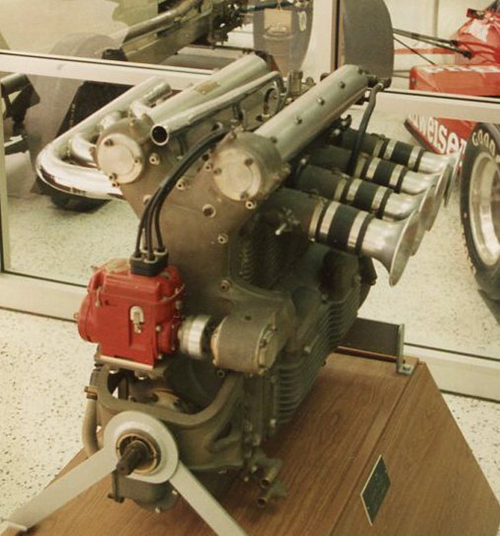
Example of a normally aspirated Offy engine as seen in the IMS Museum in May 1988. (photo HG)
Ford had just appeared on the scene with their 4.2-litre V8 and were trying to make a name for themselves. The 1963 Ford V8 had about 350 to 375hp, the highly updated 1964 version with four valves per cylinder and DOHC boasted some 425 to 460hp, depending of the fuel blend used. For the 1964 season, Ford supported more teams with the latest versions of their engines, although that was a handful of teams altogether. All the cars that used Fords were rear-engined cars: Ford was becoming a factor of some importance in the rear-engined revolution at Indy that year.

Example of a normally aspirated Ford Quadcam V8 engine as seen in the IMS Museum in May 1988. (photo HG)
The rules also allowed 2.8-litre engines with superchargers (free choice between mechanical or turbo) but the only engine of that kind in use at the time was the aforementioned Novi V8 in the Granatelli-owned team.
Nowhere in the album do we find any indication as to the kind of engine the Vaillante used. To my knowledge, nothing has ever been suggested about what engine the car had in any of the following Michel Vaillant albums either.
We had to wait for more details about the car until 2009 when in a quite unheard of manner we finally found out more about the Vaillante Spéciale Indianapolis. In 2008, a series of scale models of cars appearing in the Michel Vaillant comics was released in France. Number 25 of this series was released in 2009: the Vaillante Spéciale Indianapolis. The booklet with the car contained a number of background stories with some surprising details.

Scale model of the Vaillante Spéciale Indianapolis as released by Altaya Models in 2009. (photo HG)
To begin with, the car was said to be a 1964 model, participating in the 1964 event, so one year earlier than I believed it to be, as argued above. But let's take the mention of 1964 for granted for the time being, I will get back to the car's year of origin and the story later on.
Much more bewildering than everything about the year is the background information the Altaya booklet supplies about the car and how it was supposed to have come along. I honestly wonder if Jean Graton ever had such a plot in mind when he wrote the album. And if he did, why did he never give the slightest clue about it in the actual album or the succeeding ones? Nor can I make up my mind if the plot given in the Altaya booklet is supplied by or compiled in cooperation with Graton Editeur or that it is simply brought together elsewhere and without input from anyone at Graton Editeur. In short, according to the booklet, Vaillante was already thinking about the future in F1 with a new formula for 3-litre engined cars coming up, and Jean-Pierre Vaillant believed Indy to be a good testcase for the new 3-litre V12 engine Vaillante was working on for the formula. Curiously, Altaya is one year off by saying that the new 3-litre formula was introduced from 1965 on, as it was in 1966 that F1's engine capacity was increased to 3 litres. (So does that perhaps mean that they were a year off with the Indy adventure as well?)
Anyway, the Spéciale Indianapolis is listed as powered by the upcoming F1 engine that Vaillante was working on. It is a 3-litre, 48-valve V12 engine with a bore and stroke of 78.5x51.5mm, so a short-stroke engine. It is capable of 430hp at 11000rpm.
So despite having less than 75% of the capacity of its primary atmospheric opposition (Offy and Ford), the V12 was producing approximately the same amount of power. Those engineers at Vaillante were doing miracles! Think about this: in 1966, when F1 moved to the 3-litre formula, no V12 was capable of delivering a reliable 430hp yet. If an engine like this had been used in the 1966 Vaillante F1 cars, it had had the potential to leave its opponents for dead. But let's not forget the lesson of the true cars that inspired the Texas Drivers Novi: being way more powerful than anything else on the track doesn't make that car the instant runaway winner.
At least in theory, the Spéciale Indianapolis' power was on par compared with the best of its 4.2-litre opponents, but at 580kgs it wasn't a heavyweight like most of the Offenhauser-powered front-engined cars. So it probably handled better thanks to its mid-engined layout. Nevertheless, was using an engine smaller than permitted (giving away more that 25% of the allowed capacity!) the way to go at Indy? As its power output was in the ballpark of the genuine Indy engines, that leads to the conclusion that apart from being a higher-revving V12 the Vaillante engine also must have been much more highly tuned than its American rivals, and so more stressed as a result. What kind of effect would that have had on its reliability?
After WW2, there are two historic precedents at Indy for a car fitted with a (much) smaller engine and being underpowered because of that, yet still doing well. The winning car of 1951 used a 4-litre version of the Offenhauser, all other atmo Offies were 4.5-litre. That smaller engine was used in a lightweight car for which it was hoped that with a faster revving engine the car would still be competitive. It won, thus it confirmed its hopes. But I have my doubts whether Jean Graton was aware of this example of a smaller engine and was inspired by it one way or another.
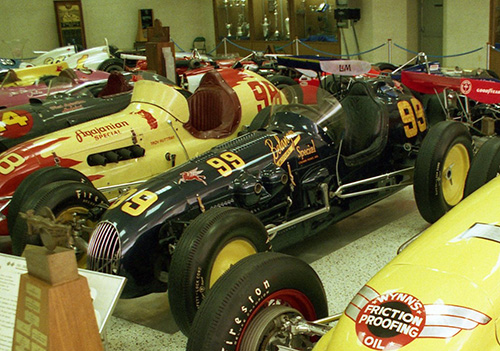
Anything but a great picture of the car it is all about. But in May 1988 this was the best possible picture I could take of the Belanger Special, the winning car of the 1951 Indy 500, this despite giving away almost 10% of the maximum engine capacity allowed. (photo HG)
The other case is the legendary Cooper-Climax of Jack Brabham in 1961, a 2.7-litre engine giving away a massive 1.5 litres to its atmospheric opponents. But the lightweight, rear-engined car had a superior roadholding in the corners that made the car competitive. Brabham finished 9th, which was a decent result.
So fitting the Vaillante with a smaller-capacity engine and putting it up against larger-capacity engines, it was a strategy which had been done before. But to say that it was the way to go? Only in the case of having a devastatingly superior advantage that made up for the power deficit.
Anyway, the story tells us that the two Vaillantes' qualifying speeds are almost to be impossible to believe, but they are so fast that they end up in the first two starting spots. Especially given the engine concept of the car that is indeed an astonishing performance.
The engine concept of choice by Vaillante (a V12) had another thing going against it at Indy, since the history at Indy had proved that fate had been cruel on multi-cylinder engines, at least those with more than eight cylinders.
Since the revival of the Indy 500 after WW2 in 1946, the winning car in '46 had used a straight-six engine, but from then on, between 1947 and 1964, all races had been won by 'Offy' fourbangers. In 1965 it was a (Ford) V8 that powered the winning Lotus driven by Jim Clark. Before the war, some race winners had been powered by straight-eight engines but no engine with more than eight cylinders had ever won at Indy. in fact, over the years only a few of such engines had been entered at all.
V12s had been ultra-rare at Indy since 1946. A genuine 1939 Mercedes GP car fitted with a supercharged V12 had been entered in 1947 and '48 and proved to be fairly quick in practice and qualifying. But without the full factory support and knowledge about the car available, the car failed to make an impression against much simpler American-built cars. Still, it could be worse.
In 1952 Ferrari had tried to qualify with their by then redundant 4.5-litre cars used in F1 the previous year. Despite the power output being acceptable, the V12 had so little torque that the cars had difficulty getting up to speed on the straights. The theoretically less sophisticated Offy fourbangers were less powerful yet had so much more torque that they pulled out of the corners like mad before reaching their top speeds. Out of the four Ferrari V12s entered only a single example qualified for the race. The three other cars were left and abandoned. Two more attempts with a Ferrari V12 in later years also failed dramatically: Multi-cylinder engines definitely were not the way to go at Indianapolis.
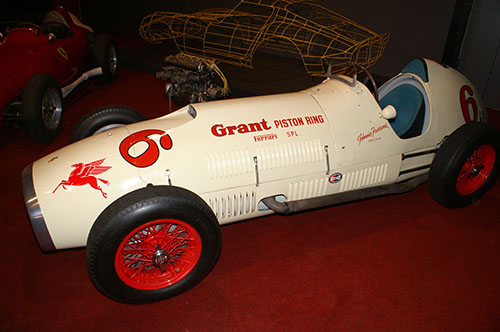
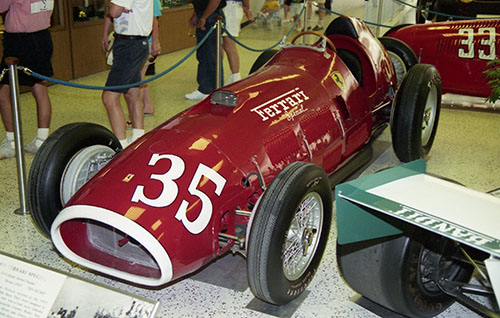
Two of the four Ferraris entered at Indy in 1952 but both failed to qualify. The white #6 was seen in the Dutch Louwman museum in 2007, the red #35 was photographed in May 1990 at the IMS Museum. (photo HG)
Short-stroke engines are not known for their torque levels, so if a high-revving 3-litre V12 engine would have stood a serious chance of being competitive at Indy against the 4.2-litre Offy and Ford?
For the record, I refer to the Offy as 'theoretically less sophisticated', but it needs to be said that the Offy had proven for quite some time to be more than capable for the job and did what was asked from it. It was a truly remarkable engine.
A final observation: the car is told to have a fuel capacity of 220 litre but how to cram all that fuel into that little car? Besides that, when seen from the side, the engine bay looks fairly small to accommodate a long engine like a V12 and there is little to no overhang of a gearbox visible either. Were they really capable of making a V12 that compact already in the mid-sixties? If you wish, make that a compact driveline consisting of a V12 and gearbox as the Spéciale appears to have?
And when we talk about fuel, there is yet another detail to mention. Until 1962 all Indy participants used methanol or a fuel primarily containing methanol. Then, when Ford entered the Indy scene in 1963, teaming up with Lotus, they went for gasoline in order to save time with pitstops. A strategy that almost succeeded and was possible due to the lightweight Lotus chassis being fairly easy on its tyres. The less fuel was carried, the better the tyre wear became. Gasoline gave very good fuel mileage at the expense of some power. The strategy almost worked and showed the potential of the idea. Ford stuck with the strategy to use gasoline on Race Day one year later but as fate it would have it with catastrophic results. USAC changed the rules for 1965 by mandating that each car was required to make at least two pitstops on which the fuel hoses had to be connected onto the car. The idea behind that was if the fuel hoses had to be connected the teams would refuel the car as well, thereby eliminating the strategy to use high-mileage fuel blends and go for methanol instantly. Contrary to what is often mentioned that gasoline was banned at Indy in 1965 already, it wasn’t. The ban came later on but in 1965 the use of gasoline was made less attractive yet was not forbidden, a rule-making strategy that had been employed frequently at Indy.
The question is whether all of this could have been known already to Jean Graton at the time he drew Suspense. Anyway, given the fact that the Vaillante Spéciale used an engine set to be used in F1 eventually, and the fact that at that time F1 engines were mandated to use commercially available gasoline fuel, the question can be asked what kind of fuel the Vaillante V12 was supposed to be using in the Suspense adventure. For the record, the 1964 Ford engines used a methanol blend in practice and qualifying, while after qualifying the engines were sent back to the factory for a rebuild enabling them to run on gasoline in the race.
But of course, none of all these thoughts cause any problem in Suspense. It is simply an imaginary adventure and Jean Graton could dream up anything he wanted.
I personally wonder if Jean Graton ever put down those specifications for the Spéciale when he created the album in the mid-sixties. But then where did the specs and the plot behind it as printed in the Altaya booklet come from? Who made them up and was anyone related to the Graton family or the editors of the original comic involved with them?
But anyway, assuming that it was indeed a 3-litre V12 car that was used by Michel and Steve, it does mean that Jean Graton repeated something in Suspense what he had allowed to happen before in Le Grand Défi: Michel Vaillant winning the race at Indianapolis in a car with a much smaller engine than his opponents! (In Le Grand Defi Michel beats the 4.2-litre Offy Roadsters and 2.8-litre supercharged Novi with a slight modified version of the then current F1 car powered by a straight-six engine of only 2.5 litres.
As for the importance and status of the Spéciale among all the Vaillantes that were created by Graton, although not being raced the car is brought back into the spotlights for presentation duties in the 13th album of the series (Concerto pour Pilotes), Michel driving the car during a special presentation by the Vaillante company at Le Mans. The car is said to be the winner at Indianapolis.
There is additional proof of the somewhat special status that Suspense may have over other adventures. Within the Altaya Michel Vaillant model range it is fairly common that apart from the Vaillante that featured in an album and was released as a model, the car of the principal opponent is released as a model as well. Altaya did so, however, with only two albums in which the main opponent drives a car inspired by truly existing cars. Coincidentally these are two albums in which Vaillante is up against the Texas Drivers Club, and one of these is indeed Suspense from which (apart from Michel's Vaillante) Payntor's Novi #4 was released in 2010 as number 32 in the series of 50 releases. The booklet that accompanied the Texas Novi model contains some drawings of the car as it appears in the album. It also features some pictures of genuine Novis. But curiously, not a single picture from the actual cars that inspired either version of the two Texas cars that appear in Suspense is to be found in the booklet! Which is a pity, as the booklet's contents devoted to the Novis at Indy are quite accurate. By the way, the booklet also doesn't give any clue to the year in which the Suspense adventure supposedly takes place.
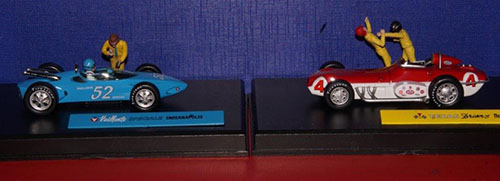
The numbers 25 and 32 in the Altaya Michel Vaillant Scale model series, the two cars appearing in Suspense à Indianapolis. A case of 'The Beauty and the Beast'? (photo HG)
?5 Despite the evidence for a 1964 adventure: why it's still a 1965 story for me?
I have already mentioned that there are identifications for the sports-prototype as a 1964 car. Altaya tells in their info booklet that came with the model of the Spéciale Indianapolis that it was supposed to be a 1964 car.
That would make the previous adventure a 1963 adventure. But that featured a Honda F1 engine that in reality was not introduced until a year later! Or must we judge this Honda engine as a piece of fantasy by Graton which by coincidence was coming true one year later?
Anyway, if the Spéciale was indeed a 1964 car and the album a 1964 adventure, it explains to some extent the appearance of at least two 1964 Indycars and a rundown of cars entered at Indy in 1964 named by Jean-Pierre in one of his discussions. But then there is that one discussion in which Jean-Pierre recalls seeing Jim Clark almost win Indy the previous year. Since that was in 1963, and because of the 1964 Honda appearance I think the Altaya publishers are a year off: I still believe that the best determination of year in which this adventure took place, based on arguments and data, must be 1965.
Then there are two very important giveaways in the album that make it simply impossible to be an 1964 adventure. The first of these clues appears on the very first page in the very first drawing of Suspense. We see one of the members of the Texas Drivers (his name is Miller, no first name ever given for him) driving a Ford Mustang. But the Mustang was not on sale in the first half of 1964 yet, let alone that Miller could drive one late-1963! Ironically, the Mustang was the real pace car of the Indy 500 in 1964 and one of the most beloved ones ever.
For the second giveaway why this adventure can't be a 1964 story we need to look to the few clues about the time path given in the adventure. The only timeline points given are the fact that Michel Vaillant and Steve arrive in Indianapolis in 'early May'. Practice that year started on Saturday May 1st, the first day of qualifying (Pole Day) was Saturday May 15th so the arrival of Steve and Michel was indeed in early May. The album tells that Michel and Steve spend a month at home in France after the second of the sportscar races. There is no time period given between these two sports car events. It could be a week, but nothing excludes it to be longer than that. Anyway, all of that allows us to conclude that the second sports car race appears to have taken place in early April.
I have a suspicion that a few readers with knowledge about the history of one particular car know by now what the second giveaway is that excludes 1964 as the year of the adventure, because the second clue deals with yet another Ford that appears in the album.
In the two sportscars races preceding Indianapolis, the Texas Drivers team used an early version of the Ford GT40. Now without going into details about how the Ford GT40 project started, there are a few days in the history of the GT40 of importance in relation to this adventure. The very first Ford GT40 prototype was finished on April 1st in 1964, the second one some ten days later. Both of these cars were hurridly prepped for the Le Mans test weekend of April 18 & 19, where it was discovered that the cars still needed an awful lot of work to be ready.
So, if Suspense à Indianapolis,was to take place in 1964, then, at the time when Ford was still working very hard on preparing their first prototypes of the car and get it ready for Le Mans in June later that year, the Texas Drivers were already running a GT40 and with quite some success! (Third and second place in these two races isn't a bad result.)
Then, as already mentioned in the info booklet with the model of the Spéciale Indianapolis, according to Altaya the new 3-litre F1 regulations started in 1965, but in reality that was in 1966. So if Vaillante was trying their upcoming F1 engine the year before in an Indycar, that would have happened in 1965.
Anyway, despite the year 1964 mentioned for both Vaillante types in the album, for me there is much more evidence against that year and instead that the adventure must have taken place in 1965.
And to top it all off: although I have avoided mentioning it until the very bitter end, now is the time to tell that Jean Graton himself has answered the question about when the race he drew took place. On page 58 of the album, in the starting procedures for the race we can see the pace car standing in front of the field. and on the rear panel of the car we can read some words among which: May 30th, 1965. So that must by now settle once and for all the year in which this adventure took place. But we'll get back to that race date one more time later on.
Indianapolis in the mid-sixties according to Jean Graton: where did the inspiration come from?
In Suspense, Graton gives a lot of attention to how a month of May at Indianapolis proceeded, with a lot of drawings that give a fairly accurate view on how things looked at that time at the Speedway. He does a much better job in this than in Le Grand Défi. He also drew a fair number of cars and told some details about them. One car was familiar for me: a 1963 Mickey Thompson Special. One other car is mentioned by name, the BMC Aston-Martin-Cooper. Many years later I found out this was indeed an existing entry for the 1963 race.
Where did Jean Graton obtain all this knowledge?
I already mentioned the fact that Altaya released a model of Payntor's Texas Drivers Novi #4. The info booklet that accompanied the model also contained info about how Jean Graton got his information used to create Suspense.
Jean couldn’t afford to travel to the US so instead he contacted NASCAR boss Big Bill France for more info. France supplied Graton with photos and other material Graton needed for the album. A bit surprising that France as NASCAR president still took the efforts to gather enough data about Indianapolis, which was really not his thing or interest. Given the final result as finished by Graton, he did a fantastic job in gathering and supplying material for Graton. This is something that is also acknowledged in the particular article.
Then, an interesting question arises: what kind of material had Bill France gathered and provided to Graton?
Now for the record: I was a 12-year-old boy when I got my copy of Suspense in 1973. Together with Le Grand Défi, the album started my interest for Indianapolis and Novis. But it took me another eight years before I began to build up my library of Indianapolis annuals. (Thank you, Carl Hungness Publishing.)
And it was in December 1983 (ten years after I got the album) that I made a stunning discovery about Suspense. This happened when I got hold of the majority of the Indy 500 annuals published by Floyd Clymer between 1946 and 1968. Among these were the 1963 and 1964 annuals. Going through the 1963 book, it took me a few seconds to realise that the Texas Drivers Club Novis in Suspense were inspired by two of the three Novis that started the 1963 race. These were the two Type 500K cars built in 1962. That menacing intimidating Texas Drivers car was inspired by a truly existing car that raced in 1963. Two such cars were driven by Jim Hurtubise (red #56) and Bobby Unser (yellow #6), by then names familiar to me. So the mystery of the origins of the Texas Novis was solved at last.
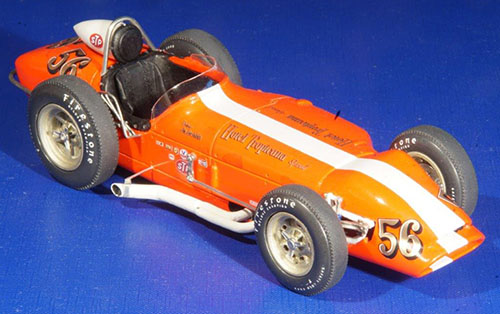
I can't use pictures of the genuine 1963 Novis that were the inspiration for Jean Graton for the Texas Drivers Club equipment. The best I can do is use a picture of a scale model, in this case the #56 driven by Jim Hurtubise. This model started out as a 1:25 resin kit manufactured by Lance Sellers, a familiar name among providers of Indycar resin kits. The #6 sister car could be made with this kit as well. (photo HG)
But there was something else about that 1963 yearbook. Several pictures looked so familiar, too familiar.
About the pictures that Graton got from Bill France, I am near dead certain that the source for these pictures was the same as at least one of the sources for pictures used in the 1963 Clymer Indianapolis 500 yearbook. Or maybe that one of the other items that France sent to Graton was a copy of this particular book. I personally believe that it was likely much cheaper and easier for Bill France to obtain a copy of the book (sold for $3 at the time) than getting a load of printed pictures he had to obtain from a press agency.
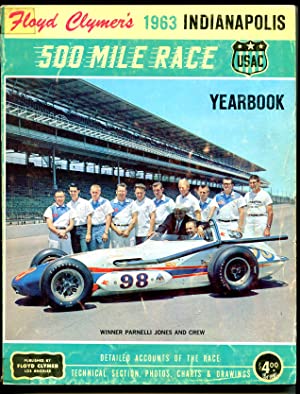
The cover of the 1963 Floyd Clymer Yearbook.
Several drawings in the Suspense album are carbon-copy reproductions of pictures that (also) appear in the aforementioned 1963 Clymer. There are also drawings which are heavily inspired on pictures in the book, although no direct copies anymore. Another thing that is obvious: several pictures are inspired on pictures in the Clymer but the cars in the picture are replaced by one or both Vaillantes. All of a sudden it became obvious to me as to why the scenery in the storyboard looks so convincing and realistic, far more realistic than what Graton had made of the location in the previous adventure in which Indianapolis appears, album #1, Le Grand Défi of 1959, since here in Suspense a number of drawings are inspired by pictures taken at location. For those who own copies of Suspense and the 1963 Clymer, here are a few examples of matches between the two books. Page 44 of Suspense shows drawings of some incidents at the track, spins and crashes.
Row 1, left picture is inspired by a sequence of pictures appearing on page 125 of the Clymer. The number on the car in the drawing is difficult to read but it is in the 50s. The real accident took place with John Zink Special #52 driven by Lloyd Ruby, but the colours of the real car were different.
Row 1, right picture is inspired by a sequence of pictures on page 209 of the Clymer in which we see the spin and crash of Eddie Sachs in car #9 on Race Day. Graton gave his car an unreadable number and colours that are different from the real car.
Row 2, left picture, now this is a real funny one. This is actually Bobby Unser driving a Novi after crashing out after two laps on Race Day. Numbers match but the real car was yellow instead of green. Green cars were a rarity at the Speedway to begin with! But although no attention to the detail is given, this is one of the real cars that inspired the Texas Drivers Novis.
Row 2, right picture is inspired by a picture appearing on page 79 of the Clymer, but that picture is blurry and it is impossible to identify the car that spun.
Row 3, left picture, is a much modified drawn version of a picture that appears op page 131 in the Clymer. In the original picture and drawing the numbers are identical but Graton turned a black-and-gold car into a white-and-red car in his drawing.
Page 43 of Suspense contains at least two drawings inspired by pictures in the Clymer. Row 2, right picture is a near carbon copy of a picture on page 139 but Graton turned a light-coloured car into another green car.
The drawing in row 2 on the left, however, became funny and highly remarkable many years later after Suspense was published. In it we see two Roadsters from behind, numbered 16 and 46. It is inspired by a picture on page 138 in the Clymer in which two cars with the same number appear. The 46 in the drawing deserves some more attention, it will get this at the appropriate place.
There are many more examples to give but since the pics I listed feature cars that can at least to some extent can be identified let's leave it at that. Let's now return to the the Texas Drivers Novis and how they came into the story.
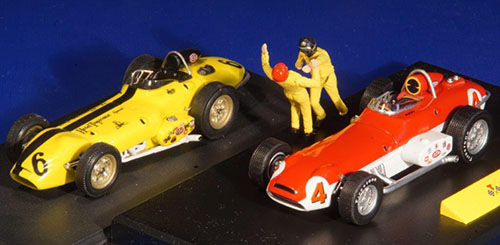
The SMTS company released whitemetal 1:43 scale kits of the 1963 Kurtis 500K-Novi, either to build yourself but fully built-up versions were sold too. Here is an example of a factory-built #6, parked next to the Altaya model of the Texas Drivers Novi, #32 in the Michel Vaillant Models series. The #6 is a model of the car that does appear in Suspense as described directly above this picture. (photo HG)
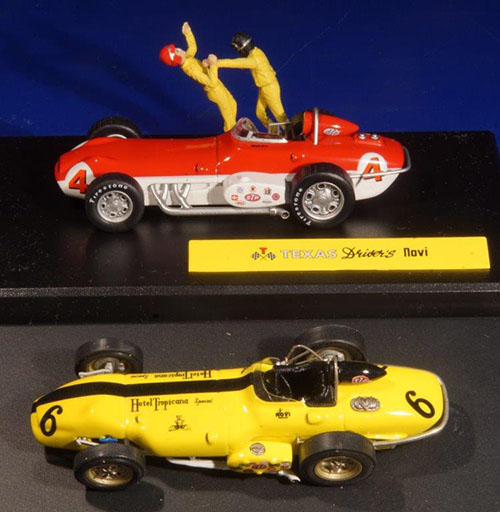
Another picture of the two 1:43 Novis shows even better that the Altaya car is inspired by the real car yet definitely has some differences in dimensions and details. It was reflected in the price I paid for each car when I bought them...
(photo HG)
I never received a clear answer from Jean Graton whether the availability of so much photo material (be it as prints or through a copy of the 1963 Clymer) has influenced his decision to have the Texas drivers use the '63 versions of the 500K Novis. But whatever his reasons, if they were on purpose or not, the Texas Drivers got by far and away the car that suited their image and reputation the best of all.
And if he indeed had a '63 Clymer at his disposal, you can't blame Jean for using the book for additional purposes! But while making good use of the book, Graton made one big error.
We already mentioned how in a drawing of the pace car Graton revealed that the race in his album supposedly took place in 1965, on May 30th to be exactly. The drawing in question is derived from a picture and the real pace car used that year, a Chrysler 300K which had a text on the rear panel like Graton put on his car, only changing the year. But Graton should also have changed the date! Indeed, most of the 500-mile races up until then had been run on May 30th. But if May 30th was a Sunday, then the race would be postponed to the next day, something that also happened in 1965. The 1965 Indy 500 was held on May 31th!
As to what other photographic material related to Indianapolis Graton obtained to create Suspense, I have no clues. The album contains in one way or another a few cars that were seen in 1964. On one occasion Jean-Pierre Vaillant mentions a few by their actual names but I could not identify any source as having been the inspiration for drawings featuring a 1964 car. I own a 1964 Clymer but there is no picture in that book that I felt to be familiar because of Suspense. But it was this book that eventually enabled me to identify two other cars appearing in the story.
I already mentioned that on the very first page of Suspense a front-engined Indycar numbered 2 appears that, when taking a closer look, resembles a Novi. Once I had gone through the 1964 Clymer it was clear for me that this car is a historically correct version of one of the 1962-built 500K cars but this time with the bodywork one of those 500Ks carried in 1964. In this first-page drawing, that particular Novi even carries the correct name of the car in 1964: STP Special!
I wrote 'a historically correct version of one of the 1962-built 500K cars' for good reason. Although both two existing 500K-Novis were entered and raced in 1964, their bodywork was modified compared to the year before and both cars differed slightly from another in 1964: they were no longer nearly identical as in 1963. And at least for me, the drawing of the car is in an angle that makes it difficult for me to identify it beyond doubt as either the 1964 #3 or #28 Novi. The drawn #2 resembles the true 1964 #3 best of all. It leads to the funny situation that in the Suspense album the 1964 version of the Kurtis-Novi 500K appears and disappears before the 1963 version enters the scene.
But also that rear-engined MG Liquid Suspension Special that appears on the second page of the album is indeed a genuine 1964 Indycar that started the race. Graton's version of the car resembles the real car very well. That inspiration must have come from somewhere.
Even more telling proof that 1964 material must have been at hand for Graton is seen on page 42 of the album where the very last drawing in the right-bottom corner features a man seen on the back. His jacket has the text Mickey Thompson Sears Allstate Tires Special on the back. Sears was Mickey Thompson's sponsor in 1964. In 1963, however, it was Harvey Aluminium. I could not find a picture resembling this drawing in the 1964 Clymer. But funnily enough, although no mention is made of Mickey Thompson, on the next page in the last two drawings we can see one of Mickey's Harvey Aluminium Specials of 1963. These drawings were inspired by pictures in the 1963 Clymer.
It remains, however, an interesting question as to why, since it looks as if there was some 1964 photo material available for Graton. So why did he not make more use of that material in the Indianapolis part of the story? And why is this part almost entirely inspired by material originating from 1963?
But then Suspense does feature a map of the Indianapolis Motor Speedway on page 42. This drawing appears very familiar too. I found a black-and-white version of this drawing in the 1957 Clymer on pages 54 and 55. I can't tell if the Clymer was the original source or that it was printed in another publication that Graton may have had access to but it is funny that a picture of 1957 origins is used here. Remember, the very first full Michel Vaillant story, Le Grand Défi, was created in 1957. It appears most unlikely that Jean Graton could have had a 1957 Clymer in his possession at that time, so perhaps the drawing was used in a different publication as well, with a copy of that ending up with Jean Graton.
Finally, as for the cover of Tintin magazine no.44 of 1964 in which the first part of Suspense appeared, it looks as if that cover is inspired by the cover of the 1963 Clymer and/or some of its contents. The menacing car getting out of the flames on the Tintin cover has a lot of resemblances with the looks of Parnelli Jones' winning Watson-Offy of 1963. None of the cars on the Tintin cover make an appearance in the actual Suspense adventure.
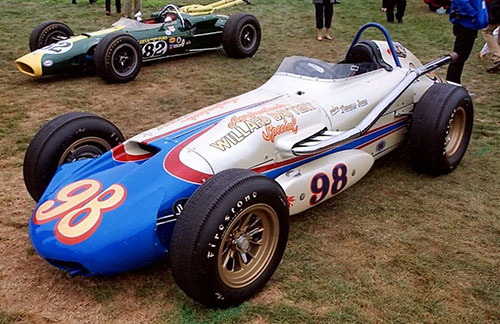
The winning car at Indianapolis in 1963, seen here in August 2018 at Pebble Beach. After winning in 1963 it was raced one more year in 1964 by the same driver Parnelli Jones who retired after a pit stop when the car went on fire. It was then retired from active duty. After that, it was obtained by the IMS Museum who had the car restored back into 1963 trim. (photo HG)
One observation to make about the album in the light of the fact that an existing book appears to be used for major inspiration is that although several cars that truly existed in 1963 appear in the album while a rundown of names of cars actually existing in 1964 appears in the story as well, the same does not apply to a single name for any driver other than the Texas Drivers! Every other driver in any of the three events remains nameless.
Now, 'just for the record...'
The race at Indianapolis as Jean Graton put it up in his album was fantasy. But if the career of Michel Vaillant as Jean Graton had drawn up until then had truly happened, Michel would have become a phenomenon in Indy history, and similarly Vaillante would have been a constructor with some remarkable achievements to its credit.
The imaginary Indianapolis 500 Record Book would have had the following records listed for Michel Vaillant and Vaillante after that 1965 race.
- First driver ever in Indy 500 history who won the first two 500-mile races he ever started, although they were not consecutive starts (1957/1958: Le Grand Défi, and 1965: Suspense à Indianapolis). A record equalled in 2000 and 2001 by Hélio Castroneves but in two consecutive starts.
- One of very few constructors that wins the Indy 500 outright in their first two starts.
- First constructor to win the race with a car with the engine behind the driver.
- First constructor to win at Indianapolis with a V12 engine.

Display of the two cars that would have made Michel Vaillant a legend in the imaginary Indianapolis 500 Record Book. (photo HG)
Then, we know by now that Jean Graton used existing cars for his inspiration. So, just out of curiosity, do some of the cars he drew up still exist?
As a matter of fact, yes. Let's give a few examples of that, beginning with the most important cars in the support cast of the story, the three Texas cars.
Both the two Kurtis 500K-Novis still exist. The one Jim Hurtubise drove in 1963 was the #3 in 1964 that inspired the Texas Drivers #2 on page 1 of Suspense. In almost an identical shape as it had as #3 in 1964, it did its last race at Indy in 1965, carrying the number #59 and again driven by Jim Hurtubise. The car survived in this 1965 configuration and is property of the Indianapolis Motor Speedway Museum. It is however rarely on display over there.
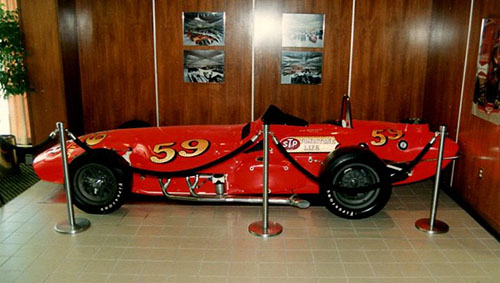
Not the best shot possible but the angle on this picture resembles quite closely the Texas Drivers Novi #2 that appears in the bottom drawing of page 1 of Suspense. The inspiration for that car was this one, the #59 in 1965. Here it is seen in the lobby of the then current Speedway Motel in May 1990, the only time ever that I got the opportunity to make a picture from this angle and in this profile. By the way, this #59 is the very same chassis that in 1963 was the #56 of which I showed you the 1:25 scale model early on. (photo HG)
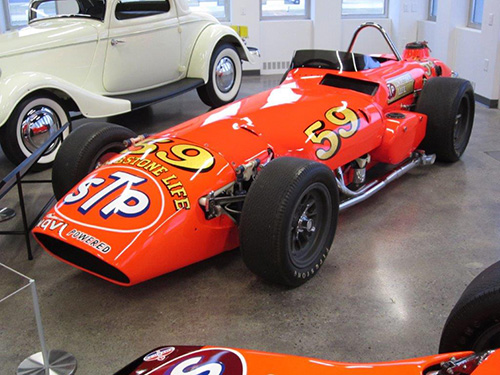
I include this picture in order to show that since 1964 this car (and the sister car) no longer had the bulged bodywork they used in 1963. Personally I think this smoother bodywork version of the cars is much less aggressive and menacing than the 1963 versions were. This version for me is less appropriate and less fitting for the cars fielded by a near criminal gang such as the Texas Drivers Club. (photo copyright Walt Schaub, used with permission)
I need to make one comment about the real Novis in their 1963 trim and their specs in the two years after. Eagle-eyed people might have seen it already on the pictures above. In 1963, the cars used larger diameter and also narrower tyres than in the two years that followed. Besides that, from 1964 on, the track width of the cars' front and rear had been extended as well. But in Suspense Jean Graton drew the cars as they were in 1963, narrow-tracked and on the larger diameter, narrow tyres.
The sister car driven by Bobby Unser in 1963 did one more race in 1964 (the white #28), but nowadays is exhibited in the Unser Museum in Albuquerque, New Mexico in almost exactly the original trim as Unser drove it in 1963.
Lotus built three examples of the Type 29. Two of them were raced by Jim Clark and Dan Gurney, the third was crashed in practice by Gurney. Following the post-Indy 1963 history of the cars is notoriously difficult since several of the cars ended up in different hands and ownership. I have no definitive confirmation for the further careers of two cars after Indy 1963 and/or their whereabouts. One of these was the car driven by Jim Clark (the 29/3) which appeared in the 1963 Clymer and consequently formed the inspiration for drawings of the Texas Drivers Lotus. It is generally assumed that 29/3 was the car in which Bobby Marshman crashed to his death in a late-1964 accident at Phoenix, which means that this car do no longer exist.
The third one raced by Dan Gurney is in the collection of the Indianapolis Motor Speedway Museum. It was incomplete for a long time and painted in the colors of Dan's team mate Jim Clark but since 2018 the car is in the process of being restored into the conditions as it was when Dan Gurney drove it in May 1963.
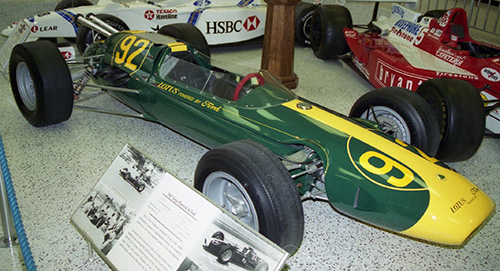
Not a really nice picture but at least it's proof. This car is believed to be Lotus 29/1, the car that in 1963 was driven by Dan Gurney. Here seen in late 2003 when the car was still painted in the colours as used by Jim Clark. (photo HG)
Several more cars that appear in the album as present during the event have survived time, if not always in the 1963 colours. For example, on page 61, row 2 drawing 2 (on the right) appears a classic Indy Roadster #88. The very same #88 appears again on the last page of the album in the drawing at the second row on the right. Both drawings are inspired by pictures appearing in the 1963 Clymer. However, the picture that inspired the drawing on page 61 has a Watson with number 8. This particular car is #15 within the Watson range and built in 1962. It drove its final 500 in 1965 and it still exists, being restored in its 1965 colours for good reasons, as in that year it was the highest finishing car of the six still front-engined cars that had qualified for the race and the only one of those (as well as the last-ever front-engined car) to complete the full 500-mile distance. This was achieved by the later two-time winner Gordon Johncock who in 1965 still was a rookie.
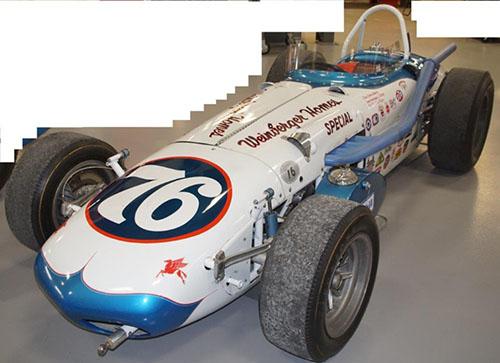
I was forced to edit the picture in order to take out as many clues as possible about where I saw this car, but this is what one of the cars that appears in Suspense looks like today. (photo HG)
This particular Watson and the Hurtubise Novi #59 pictured earlier do share a funny detail. While Suspense took place in 1965 but with Graton using a 1963 yearbook for his inspiration, these two cars are for certain at least two, if not actually the only two cars that appear in the 1965 Graton adventure but were also part of the real 1965 race.
The picture that inspired the drawing on page 64 can be found on page 194 of the Clymer and indeed features a Roadster #88, be it in different colours than used by Graton for his #88. This particular Watson was one of the cars built in 1959, and in the numbering generally used for Watsons it is chassis #5. It is still in existence today and restored to the condition it was in back in 1959. It achieved its major career feat in that very first year of existence when Jim Rathmann drove it to win the only two events for USAC cars that have ever been held on the Daytona oval.
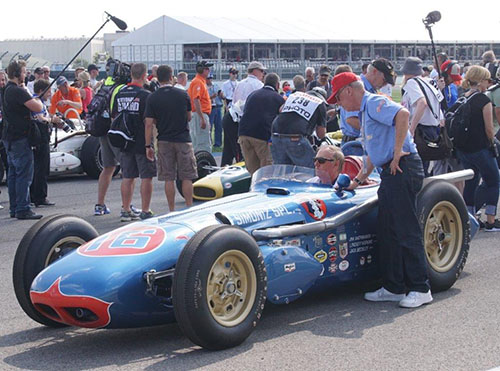
Seen in 2016 when it participated in the grid of 33 historic cars on Race Day 2016. This was the true #88 in the 1963 Indy 500 that inspired the #88 in Suspense. (photo HG)
I think it goes beyond the scope of this article to try to include pictures I have (or have access to) of all the cars that appeared in Suspense in their current state, so I close this section with showing one more car that, in much modified shape, appeared at Indianapolis in 1963 but did not qualify for the race.
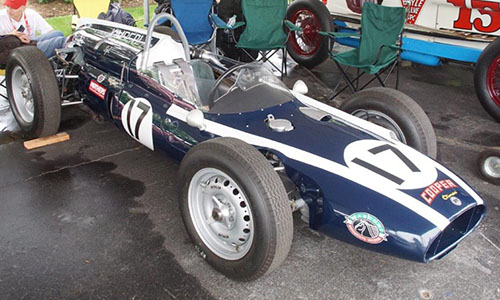
Yes, in a much modified shape this historical car also was entered at Indianapolis in 1963 and in that shape it appeared in Suspense as well. But it doesn't exist in that (Aston Martin straight-six powered) configuration anymore. Instead it is restored into its original 1961 shape. Remember that I mentioned about two historical cases at Indy when a car used a much smaller engine than permitted? This was one of those, the 2.7-litre Climax-engined Cooper chassis driven by Jack Brabham in 1961. (photo HG)
There is, however, one more car I want to give some attention to.
Most of the Watson chassis were used in several years at Indy, including in 1963. Several of them appear in pictures printed in the 1963 Clymer that have been used by Jean Graton for inspiration. One more car which still exists today is car #46 on the picture on page 138 in the Clymer, together with the #16 of that year. The drawing in question is the aforementioned page 43, second row, left picture of the album where, like in the inspiring picture we can see a #16 and a #46 as well. This #46 was entered by the Racing Associates and among Watson followers it is generally numbered the 21st built chassis. The car was not qualified for the 1963 race but one year later it was driven by Johnny Rutherford and part of the second-lap disaster in that year's race. If failed to qualify again in 1965 but was the slowest qualifier in 1966. Regrettably, Watson #21 appeared to have a sense for being involved in multiple car crashes. In 1966 it was one of the 11 victims of the start crash that marred that race. So in four years at Indy it qualified only twice, both the years in which multi-car crashes took place and as a result if officially registered only two laps under Race Day conditions. Nevertheless, the car became a significant car in Indy history because in 1965 this was the mule chassis used by Herb Porter for his experiments with his first turbocharged Offy engine and proved the long-term potential of such a project. Turbo Offy power was the key that got the car qualified in 1966, be it as slowest in the field, but in doing so it made history since it became the last of the classic front-engined Roadsters ever to make an Indy 500 starting field. Watson #21 survives nowadays in the 1966 trim, thus with a turbocharged Offy.
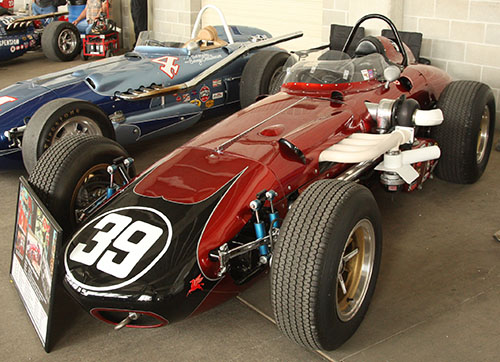
Seen here on May 13, 2011 on the day that the Speedway was opened for veteran cars. In 1963, this was the Racing Associates #46 but when the chassis was restored it was rightfully restored into the most historic configuration of its career: that of 1966. (photo copyright Mike Georget✝, image kindly provided by Walt Schaub, Oakville MO)
Maybe some die-hard Michel Vaillant fans will have a clue as to why I have paid attention to this car and included this picture, but that is beyond the scope of this write-up.
And some more personal reflections and impossibilities at, in particular, Indianapolis
So, after all the things that I pointed out, will I be able to make some more comments about what could seen as questionable or even downright impossible?
There are a few scenes in the album that leave a few questions. It starts with qualifying for the race. On page 43 it is explained correctly how cars have to qualify with an average over four laps, with the 33 fastest cars making the race. We see the first two qualifiers too. But then the three Texas Drivers cars are called up for qualifying and once they are in the field the Vaillantes are called up.
The actual qualifying process at Indy in that time was slightly different, though. On the first day of qualifying a line-up would be created by hopeful contenders, a queue built up on a 'first come first serve' basis: you had to hurry if you wanted to go out early. So no organizing or an arrangement of sequence, it was all up to the initiative of the participating teams!
One of the most outspoken people against this manner of deciding who went out first was Colin Chapman, especially after he found himself at the back of the queue in 1963. Despite the fact that the procedure was set to be retained, a change was made later on after all, when the draw was introduced. This meant that after practice was over on the Friday before Pole Day, all teams who wanted to qualify for pole on the next day had to pull their number in the qualifying line from a large bag containing marbles with numbers that corresponded with their sequence in the starting line. 'Luck of the draw' became an element in this.
In Suspense it is impossible to make up which system of determining the qualifying sequence was used. In theory it is possible that due to the luck of the draw both Vaillantes ended up at the back of the qualifying queue and also straight after each other. It is also possible that due to that same luck of the draw all three Texas Drivers cars qualified one after the other just ahead of the two Vaillantes. But how likely is that?
But if we are insecure about which rules made sure that this qualifying sequence could actually have happened, another Suspense sub-plot about which driver eventually starts in the race is cause for even more question marks.
In Suspense we actually see a replacement driver take over a qualified car shortly before the race (so on the starting grid itself!) without this being made official and him being registered as the replacement driver. In those years, replacing a driver would have meant that the car was put to the back of the grid, so to the 33rd and last spot. And that was after it was approved by the race directors. Besides that, replacing the original driver with an unknown mystery driver? Swapping drivers like it happened in Suspense would never have happened for real.
For my next series of thoughts I need to repeat myself in order to bring back the race as it went back to your memories. I already wrote:
Now, in the Dutch translation of the album the situation becomes rather confusing at this stage. First there is a discussion between team boss Henri Vaillant (Michel's dad) and his eldest son Jean-Pierre that the cars are expected to make a stop for fuel soon. Some cars are seen being refuelled and then it is mentioned that the Vaillantes wil start their charge to the lead about halfway into the race. In order to that they must pass the two Texas Drivers Roadsters that run as a pair. However, it is unclear whether this is by now the halfway point of the race already, but as several cars have already stopped for fuel it can't be that early in the race anymore.
Anyway, when Michel and Steve want to overtake the #4 Texas Drivers Roadster driven by Payntor's mysterious replacement, he refuses to make way. Then he becomes under attack of his team mate Sam Hawkins in the other (#5) Texas Drivers Roadster who makes contact with the #4! Both cars almost spin out but remain on track. Both Michel and Steve use the opportunity to pass the battling team mates and move forward through the field.
After this slight collision between the two Texas Drivers Novis there is a drawing of the Texas Drivers 'boss'. Supposedly he has seen what happened between his two drivers and intends to have a word with the driver in Novi #5 of whom he at that time doesn't know anything else than that it is Sam Hawkins. The question however must be that if the boss was in the pits how could he have seen what happened in what appears to be one of the track's four turns? There were no big screens that showed what happened elsewhere on the track!
But also, this collision took place after the first pit stops, all of which were for cars that were nowhere near as fuel-thirsty as the Texas Drivers Novis! But the two Texas Drivers had not made their fuel stop yet as becomes obvious in the continuation of the race. I already wrote:
By then the story goes to what is said to be the halfway point of the race, with the two Texas Roadsters by now a lap behind but still driving on as a pair. Together with some other cars Steve and Michel are ready to lap the two Texas cars which are still running together. Since one of the leaders is the Texas Drivers Lotus-Ford of Jones, the mysterious driver in Roadster #4 prepares to help his teammate. But yet again it is Sam Hawkins who runs his own car into the #4 to prevent any actions by the driver in #4. This time, however, the cars spin off the track. The two Texas Drivers get out of their cars and start a fistfight!
The Boss of the Texas Drivers Club is supposedly in the pits area, yet somehow he sees his drivers in a fistfight with each other. He cries out in despair, asking what is wrong with them. But again the question remains how he could see the fighting taking place if it wasn't in front of him on the straight! Standing in the pitlane you could only see part of the front stretch of the track and absolutely nothing of the infield.
And while this fight is taking place, the watching 'boss' is unaware of the fact that a driver other than Sam Hawkins was in fact driving the #5. He finds out this shocking fact when, while in sheer disbelief over two of his drivers involved in a fight, he is approached by Sam Hawkins.
In the story there is, however, not the slightest reference to the Texas Drivers Novis having made a pit stop already or of an upcoming pit stop for either of the Texas Drivers cars. And so, two questions:
A: Despite the fact that the two Novis disappeared from the race at around the halfway mark, had there still not been a pit stop for Novi #5 that would have allowed the 'boss' to have a talk with the driver because of the earlier mishap between the two Texas Novis and so find out that Hawkins wasn't driving the car?
B: No pit stop that late in the race for a Novi for, at least, fuel was absolutely impossible. How could a Novi have gone this far in the race without at least refuelling once? Certainly in the case of a 1965 race when the rules prescribed that any car had to stop for fuel at least twice in the race or, when in the pits, fuel hoses had to be connected at least twice.
Nevertheless, in 1948 a slower and less powerful Novi had required some 425 litres of fuel to cover about 100 laps. There are no exact figures of the 1964 engines' consumption but on average it can not have been much better than what they did in 1948.
The type Kurtis 500K-Novis were notoriously unreliable and unlucky cars. Data about their actual fuel consumption are few. One car got a little over halfway in 1963 and stopped for fuel on lap 48 and a second time on lap 101. That suggests that the car was on a three-stop race. One year later, that very same chassis was flagged off after a troublesome race with 191 laps covered, after stopping for fuel on laps 72 and 149. But even this comparison can't be made objectively. The engine in the 1963 car was said to deliver a maximum of 741hp and the car ran on narrow but large-diameter 18-inch tyres. In 1964 the engine output was reduced to a reported 700hp, the chassis had lost some weight and the car used smaller 15-inch diameter tyres that were much wider.
Anyway, one thing is for sure: no way that a Texas Drivers Novi could have got close to halfway without having stopped for fuel at least once. Which must have given the crew of the #5 the opportunity to find out that someone other than Sam Hawkins was in the cockpit.
Final words
There may be some more things that I could point out but… with all these comments and critical notes, one might get the impression that I feel negative towards Suspense à Indianapolis because of the many unlikely if not impossible details. But no. Anything but that.
My comments are based on Indycar knowledge, a lot of which has been obtained with hindsight. Authors have the right to create whatever story they want and to change and modify whatever they feel is appropriate in order to enhance their story, make it more accessible or obtain the desired result.
It is because of the fact that Jean Graton made use of existing and historically correct printed matter that I came up with the idea to have a look at what was real, what could have been real and what is imagination in his album. If my comments read as being harsh, this is not intended. Please regard them as observations, not as a critical outburst.
Suspense à Indianapolis and Le Grand Défi were my two first introductions to both the Indianapolis 500 and Novi race cars. I dare to admit it, both have become an important part of my life. So even with a flaw here or there, how can I be harsh on a book that has meant so much for me and has been of so much influence?
So is there no really harsh comment to make? OK, here is what may be seen as one.
Looking at the cover of the album, you see a sinister masked driver in a Texas Drivers Novi followed by the two Vaillantes. Now I can't help it but if I look at that drawing it appears to me as if the three cars are in a slight corner to the right!
Now, if there is one turn direction that the Indianapolis Motor Speedway was missing at the time when Suspense supposedly took place and was published...
Finally, having said that, allow me to close with:
À Monsieur Jean Graton, chapeau et merci beaucoup pour votre histoire Suspense à Indianapolis.
References
Publications
Dutch translations of the Michel Vaillant albums:
No. 1: Le Grand Défi (an English translation of this album released in 2007 was also used)
No. 6: La trahison de Steve Warson
No. 11: Suspense à Indianapolis
Floyd Clymer's Indianapolis 500 and Monza 500 Yearbook 1957
Floyd Clymer’s Indianapolis 500 yearbook 1963
Floyd Clymer’s Indianapolis 500 yearbook 1964
The Clymer books were published by his own publishing company located in Los Angeles, CA.
Novi, the legendary Indianapolis Race Car. Volume Two: The Granatelli Years (1961-1966), by George Peters & Henri Greuter, Bar-Jean Enterprises, Hazelwood MO, (1998)
The Illustrated History of the Indianapolis 500 1911-1994, by Jack C. Fox, Carl Hungness Publishing, Speedway, IN (1995)
Ford vs Ferrari, The Battle for Le Mans (revised edition), by Anthony Pritchard, Zuma Marketing, Marina del Rey, CA, (1984)
The Watson Years, by Gary Wayne, Witness Productions, Marshall, IN (2001)
Altaya: Les voitures de Michel Vaillant, no 25: Vaillante Spéciale Indianapolis
Altaya: Les voitures de Michel Vaillant, no 32: Texas Drivers Kurtis K500 Novi
These were booklets released with the 1:43 scale model of the listed car, released by Altaya France.
Websites
Michel Vaillant on Wikipedia
Vaillant fan club
Official Michel Vaillant website
OldRacingCars.com
I also had private correspondence with Mr. Jean Graton regarding the Novis he used in his albums. (1990)
Special thanks to mr Walt Schaub form Oakville, MO for providing images from the estate from his deseased friend Mike Georget as well as from his own collection. Walt is also the man who built the 1:25 scale model of the 1963 Hotel Tropicana #56 that appears in this write-up.
